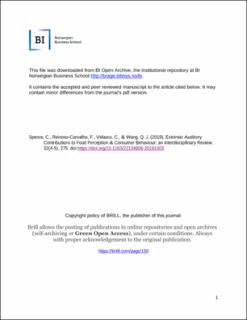Extrinsic Auditory Contributions to Food Perception & Consumer Behaviour: An Interdisciplinary Review
Journal article, Peer reviewed
Submitted version
Permanent lenke
http://hdl.handle.net/11250/2603012Utgivelsesdato
2019Metadata
Vis full innførselSamlinger
- Publikasjoner fra CRIStin - BI [1015]
- Scientific articles [2181]
Sammendrag
Food product-extrinsic sounds (i.e., those auditory stimuli that are not linked directly to a food or beverage product, or its packaging) have been shown to exert a significant influence over various aspects of food perception and consumer behaviour, often operating outside of conscious awareness. In this review, we summarise the latest evidence concerning the various ways in which what we hear can influence what we taste. According to one line of empirical research, background noise interferes with tasting, due to attentional distraction. A separate body of marketing-relevant research demonstrates that music can be used to bias consumers’ food perception, judgments, and purchasing/consumption behaviour in various ways. Some of these effects appear to be driven by the arousal elicited by loud music as well as the entrainment of people’s behaviour to the musical beat. However, semantic priming effects linked to the type and style of music are also relevant. Another route by which music influences food perception comes from the observation that our liking/preference for the music that we happen to be listening to carries over to influence our hedonic judgments of what we are tasting. A final route by which hearing influences tasting relates to the emerging field of ‘sonic seasoning’. A developing body of research now demonstrates that people often rate tasting experiences differently when listening to soundtracks that have been designed to be (or are chosen because they are) congruent with specific flavour experiences (e.g., when compared to when listening to other soundtracks, or else when tasting in silence). Taken together, such results lead to the growing realization that the crossmodal influences of music and noise on food perception and consumer behaviour may have some important if, as yet, unrecognized implications for public health.
